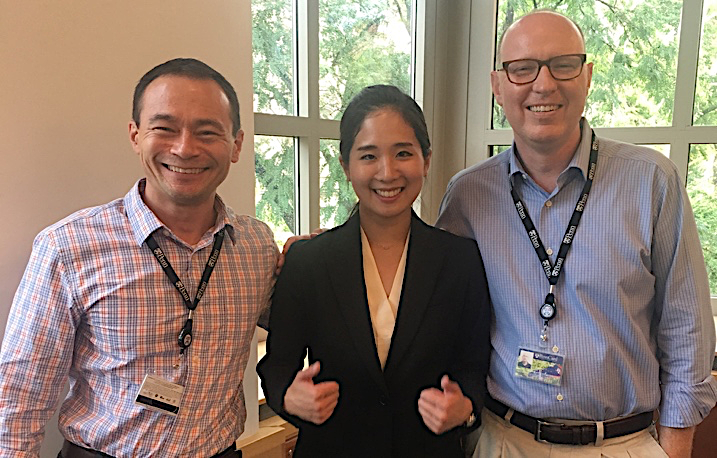Let’s meet the researchers!
Joomyung (Vicky) Jun was born in South Korea and received her B.Sc. degree in chemical biology at U. C. Berkeley in 2012, performing undergraduate research with Kenneth Raymond. She then worked with Ronald Zuckermann at the Molecular Foundry in Lawrence Berkeley National Laboratory until 2014. Her research (Ph.D. 2019) at University of Pennsylvania focused on the development of novel and underexplored fluorogenic small molecules. She was co-advised by Professors Chenoweth and Petersson. She is currently a postdoctoral scholar with Ronald T. Raines in the Department of Chemistry at Massachusetts Institute of Technology.
David M. Chenoweth was born in Indiana, USA and received his B.S. degree from Indiana University-Purdue University Indianapolis (IUPUI) in 1999. He worked at Dow AgroSciences and Eli Lilly before joining Peter Dervan’s group at the California Institute of Technology to pursue a Ph.D. After graduation in 2009, he was an NIH Postdoctoral Fellow with Timothy Swager at Massachusetts Institute of Technology. David was appointed Assistant Professor in the Department of Chemistry at the University of Pennsylvania in 2011 and was promoted to Associate Professor with tenure in 2017. He is also a member of the Biochemistry and Molecular Biophysics Graduate Group in the Perelman School of Medicine and the Bioengineering Graduate Group in the School of Engineering and Applied Science.
E. James Petersson was born in Connecticut, USA and completed his undergraduate education at Dartmouth College and his graduate study under Dennis Dougherty at the California Institute of Technology. After receiving his Ph.D. in 2005, he was an NIH Postdoctoral Fellow at Yale University with Alanna Schepartz. He joined the Department of Chemistry at the University of Pennsylvania in 2008 and the Department of Biochemistry and Molecular Biophysics in the Perelman School of Medicine in 2018. His research has been recognized by several awards, including the Searle Scholar, an NSF CAREER award, and a Sloan Fellowship.
What inspires your interest in fluorescent probes?
It is said that “seeing is believing,” and fluorescent probes allow one to directly visualize molecules in complex biological processes, often with high specificity. Small molecule fluorophores enable highly sophisticated microscopy techniques for “seeing” into the body or into cells, techniques that are essential for basic biological research as well as for the diagnosis of diseases, which I find fascinating.
What primary research are you carrying out in the area?
Although numerous fluorescent probes are known, the vast majority of these probes consist of a diminutive set of classical “core” dyes such as coumarin, fluorescein, or BODIPY. Dr. Jun’s thesis research focused on developing underexplored or novel fluorescent cores based on modular scaffolds that exhibited advantages over classic and contemporary dyes. Prof. Petersson and Prof. Chenoweth have collaborated for many years on various optically active probes, including genetic encoding of fluorescent unnatural amino acids from the Petersson laboratory and photo-convertible small molecules from the Chenoweth laboratory, as well as synergistic projects using tools from the Chenoweth laboratory in protein labeling.
How do you hope this review will help and inspire future research in the area?
One of the challenges in this field is the gap between new probe development and its practical application in a biological system, which are much more complicated than the in vitro system. Says Jun: “I hope this review can be helpful for both chemists and biologists to understand the underlying concept of fluorophore design and to reach a point where chemists can tailor the probe based on the specific biological system of interest.”
Read the full article: Rational Design of Small Molecule Fluorescent Probes for Biological Applications
See the other articles showcased in this month’s Editor’s Collection
See all the full articles on our publishing platform











